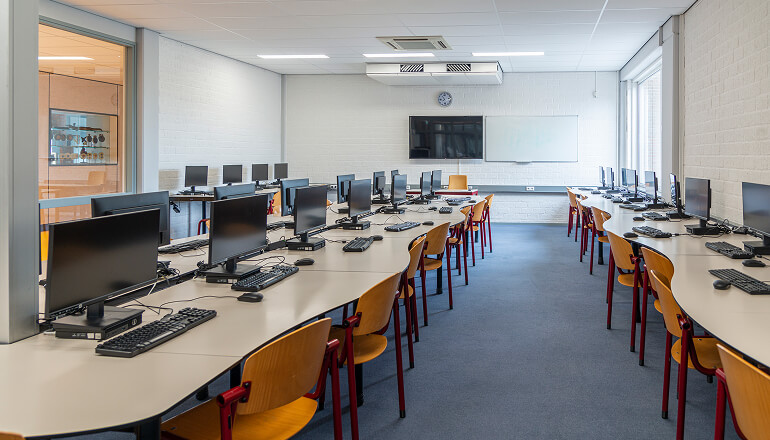Article Can One-to-One Initiatives and BYOD in Schools Increase Student Engagement?
By Susie Steckner / 9 Mar 2017 / Topics: Modern workplace

Education leaders envision the 21st-century classroom filled with students engaged in new ways of learning, thanks to technology: online courses, education apps, 3–D printers and more. But as the tech revolution works its way through K–12 schools, educators remain divided on a key piece of the movement: one-to-one computing and Bring Your Own Device (BYOD) initiatives.
These programs have each had their share of successes and failures, and their roles in the classroom will continue to evolve as the education landscape changes across the country.
This tech revolution — regardless of its challenges — has dramatically transformed the classroom.
According to the International Society of Technology in Education (ISTE), “One-to-one and BYOD are game changers, giving students access to digital tools throughout the day, across all subject areas. This paradigm shift challenges teachers to rethink and redesign learning activities to capitalize on their school’s investment in technology.”
Mobile movement
Districts began exploring the use of individual devices in the 1990s, and today there are differing schools of thought about the best way to equip each student with a device. In one-to-one computing programs, school districts typically purchase devices, such as iPads or Chromebooks, and deploy them to individual students.
With BYOD initiatives, school districts allow students to use their own devices in the classroom. In some cases, particularly with large or economically diverse districts, officials choose to implement a combination of both strategies to ensure all students have access to devices.
Regardless of what strategy school districts employ, the use of tablets and laptops is steadily growing. In fact, according to the 2017 Technology in the Classroom Survey by Front Row Education, student access to mobile devices is now higher than ever. Among the survey’s findings:
- Three out of five teachers said their use of technology would increase during the 2016–2017 school year.
- 75% of teachers said they are already using technology daily with their students.
- Increased access to devices is driving technology use, with over 50% of teachers saying they now have a one-to-one student-to-device ratio, up nearly 10%.
Districts are also largely embracing BYOD in schools, according to the 2016 K–12 IT Leadership Survey by the Consortium for School Networking (CoSN). Education IT leaders reported that district bans on student personal devices are a thing of the past; only 11% have banning policies.
Successes and failures of BYOD in schools
School districts across the country with successful one-to-one initiatives report similar results: increased student achievement, more engaged learners, enhanced digital literacy skills, better understanding of digital citizenship, and improved college and career readiness.
Districts also attribute more innovative and engaging student assignment capabilities to the wide-ranging apps and programs available on personal learning devices. However, implementing one-to-one and BYOD initiatives and maintaining those programs comes with many challenges.
In districts where initiatives have failed, critics blame ballooning maintenance costs, budget cuts, security lapses, insufficient bandwidth, incomplete training and parent concerns about overuse of devices at home. This has also led some educators to conclude that one-to-one efforts have yielded little or no results in improved learning.
Cost of change
Cost has been a critical concern — and stumbling block — for school districts implementing one-to-one programs. Beyond the initial investment in devices, districts face ongoing costs to cover implementation, training, maintenance and more.
In a 2015 survey on the future of K–12 edtech by Education Dive, administrators and teachers were asked what they thought the greatest challenges were to providing access to education technology for students in their districts. 75.9% of respondents cited budget limits, and 53.9% pointed to inadequate training for teachers and staff.
Upgrading and maintaining BYOD initiatives
Schools adopting one-to-one and BYOD initiatives face dozens of challenges associated with devices, including everything from security concerns to bandwidth challenges.
A school’s wireless network is on the front lines of any educational technology initiative, according to Insight’s whitepaper, “Fine-Tuning Critical Infrastructures in the Age of Common Core and Online Assessments.”
“The network must be reliable and efficient to ensure data travels reliably from it to the broadband network, and from there to the district data center. However, in spite of education’s increasing reliance on technology, many wireless networks are woefully unprepared to support technology deployments. Research shows that 75% of U.S. schools do not have the appropriate network bandwidth to support one-to-one computing initiatives.”
According to the report, wireless networks and data centers have a lot to support in the digital age. “They must sustainably support all core components of modern education: increased personalization, one-to-one classrooms, [BYOD] initiatives, learning management systems, collaborative learning, streaming video, and many other digital platforms and initiatives.”
In addition, the report states that education technology requires support that is ongoing. “Many school districts have upgraded these key infrastructures, but they may need modifications to guarantee the most efficient and reliable operations. Others may be maintaining antiquated environments.”
Equality of student access
One common challenge that school districts embarking on tech initiatives face is ensuring that all students can use the same technology regardless of their socioeconomic status. In the fast-moving tech world of K–12 schools, equal student access is critical.
However, digital equity remains a growing concern for K–12 educators and technology professionals. The challenge now extends beyond the classroom to students’ internet access at home. According to CoSN’s 2016 Infrastructure Survey:
- 42% of school leaders ranked digital equity, or lack of broadband access outside of school, as a “very high priority.”
- Nearly two-thirds of school system leaders do not have any strategies for providing off-campus connectivity to students. This is only a slight improvement over previous years.
“The good news is districts are making real progress in supporting modern technology infrastructure. However, it remains clear that more work and investment are needed over the long run to address the digital equity challenge of today and provide robust broadband connectivity for all students in and outside of school,” says Keith Krueger, CEO of CoSN.
Highs and lows
Schools across the country report wide-ranging success with their one-to-one and BYOD initiatives.
Personalized learning
At the Oakland Unified School District in California, teachers and students across 87 schools are using 11,000 Dell Chromebooks with the aim of crafting individualized curriculum through computer-based instruction, while also providing mobility for collaborative projects. The Chromebooks are used on a near daily basis.
“Kids love learning on the computers. They feel like they’re able to navigate the learning on their own,” says Principal Claire Fisher at the district’s Urban Promise Academy. “It gives them a personalization that sometimes doesn’t come across when you don’t have the technology there. It’s meeting their needs better than any teacher could do on their own. And it’s also cutting back on the time a teacher would need to craft all those lessons at the different levels.”
The technology is also sparking new interests in students. As one Urban Promise Academy student says, “Now I want to learn as much as I can about coding and learn as much as I can about computers.”
New way forward
At the River Dell Regional School District, students using HP Notebooks are focused on a learner-centered model. This means they create content in ways that wouldn’t be possible otherwise, both locally and online. They work anywhere, anytime, both in and out of school. Teachers post assignments, links and other information for students and parents to access from wherever they have an internet connection.
“The one-to-one program is not about the device, it’s about learning,” says Marianthe Williams, the district’s technology director. “Our students have engaging, empowering learning experiences both in and out of school that prepare them to be active, creative, knowledgeable and ethical participants in our globally networked society.’’
BYOD boost
At the Katy Independent School District in Texas, leaders were concerned about sustainability for a one-to-one program and instead opted for a BYOD strategy. A range of Cisco technologies support the program, and teachers use many engaging applications for students.
Government and History Teacher Kay Fenn noted the ease with which students can grab their mobile devices and jump into an assignment. “We can do on-the-spot research, which has really enhanced the classroom environment. Plus, we use tools like Poll Everywhere.com (an audience response system that leverages smartphones, Twitter and the web), and kids text in their answers to questions I pose for them.”
Future for classrooms
As one-to-one initiatives across the country evolve, educators will continue to face several issues. According to CoSN’s 2016 Leadership Survey, enabling mobile infrastructure in schools will dominate education leaders’ priorities in the coming year. Respondents rated broadband and network capacity as their number one priority, followed by wireless access and mobile learning.
CoSN’s 2016 Infrastructure Survey also indicates that the increasing use of mobile devices, digital content and online assessment is driving these priorities — and school leaders expect to see an increase in the number of devices in the classroom. According to the survey:
- 37% of school systems reported an average of one device in use per student (up 9% from 2015).
- 21% of school systems reported an average of two or more devices in use per student.
- In three years, 65% of school systems expect to use an average of two or more devices per student.
“It is clear that school systems need to plan for robust, ubiquitous learning environments, often with students accessing multiple devices,” the survey says. However, many school districts are still lagging behind their projected growth goals, despite increasing internet connectivity.
“As education goes digital, school system technology leaders face many challenges in planning their future education networks, especially around factors of affordability, network speed and capacity, network reliability, and a lack of competition for broadband services in too many communities.”






